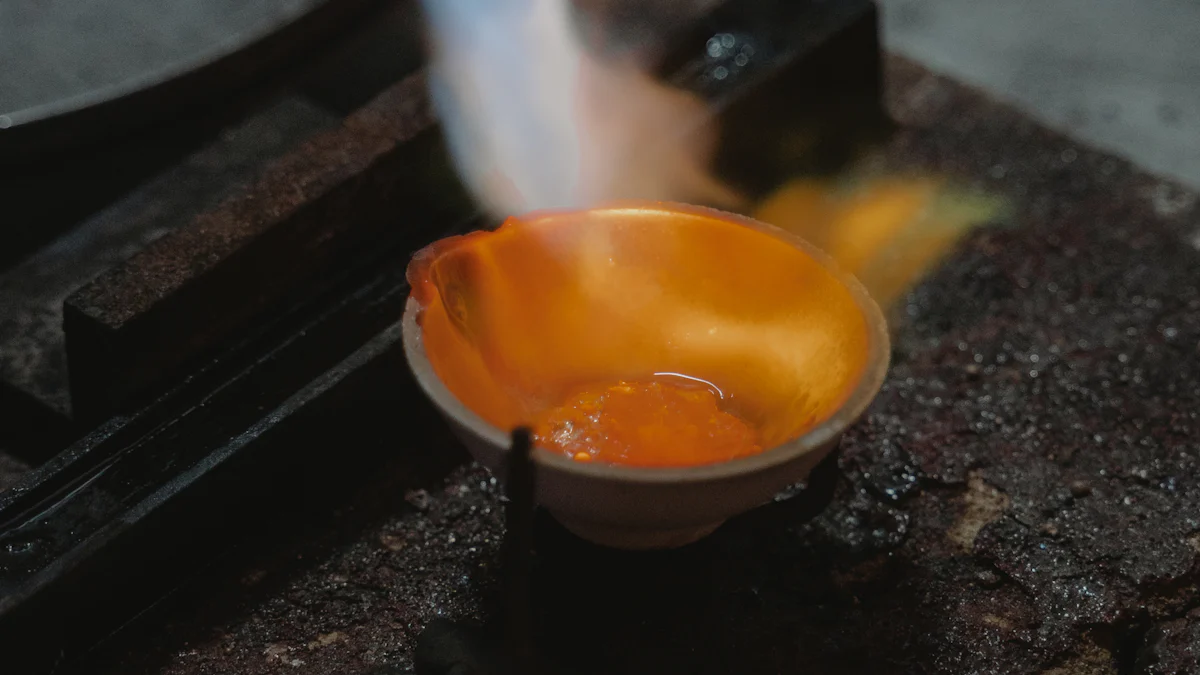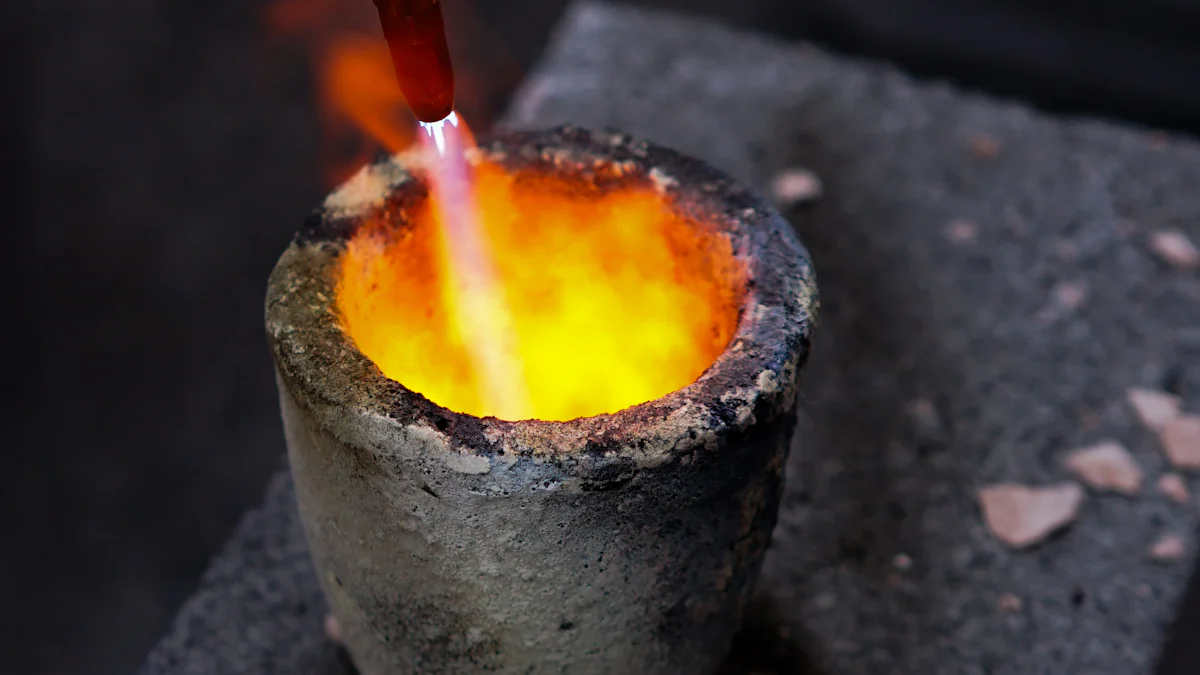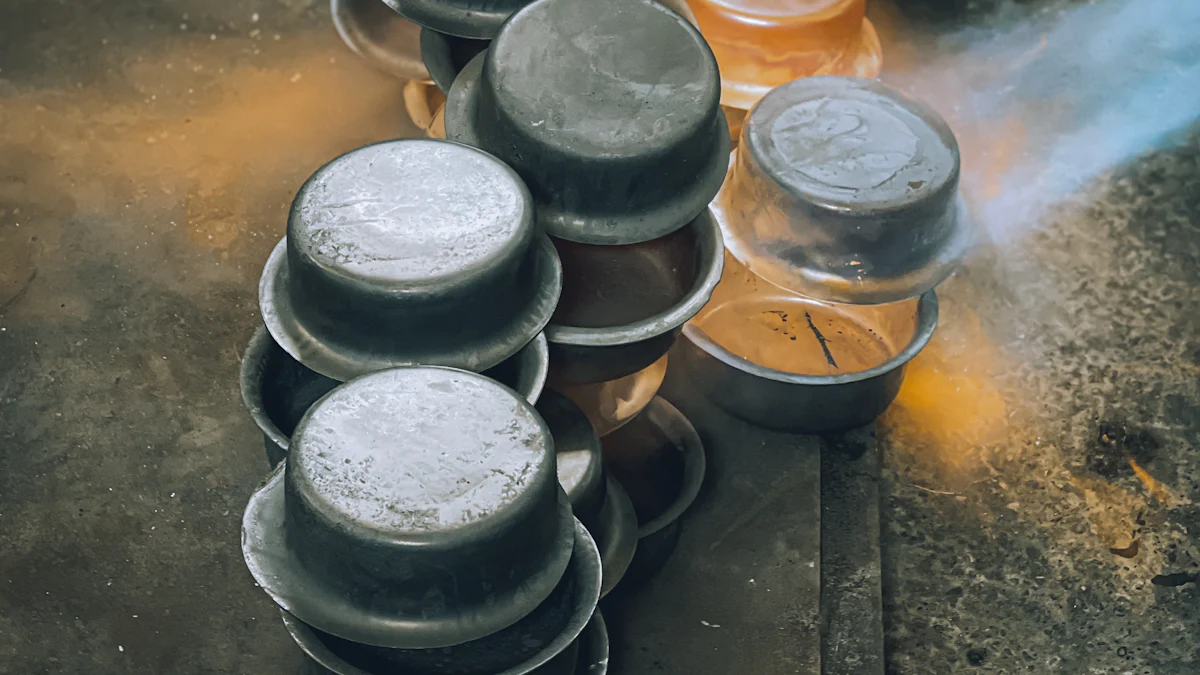
正しい選択 硬質フェルトるつぼ is crucial for achieving optimal results in metal melting and holding applications. These crucibles, crafted from high-purity materials like graphite and ceramics, withstand extreme temperatures and harsh chemical conditions. Their high thermal shock resistance makes them ideal for foundry applications, where rapid temperature changes are common. The Rigid Felt Plate Crucible, in particular, integrates specialized materials to enhance heat stability and minimize thermal loss. Choosing the correct crucible ensures minimal contamination and maximizes efficiency, making it an essential decision for any industrial process.
要点
- 適切な材料を選ぶ: Opt for graphite for high thermal conductivity and chemical resistance, or ceramic for stability at high temperatures.
- Consider temperature resistance: Ensure the crucible can withstand the specific temperatures required for your melting processes to avoid structural failure.
- Evaluate thermal shock resistance: Select crucibles with high thermal shock resistance to handle rapid temperature changes without cracking.
- Ensure material compatibility: Verify that the crucible material does not react with the metals being melted to prevent contamination.
- Follow proper handling techniques: Gradually change temperatures and evenly distribute loads to extend the crucible’s lifespan.
- Maintain cleanliness: Regularly clean crucibles with non-abrasive tools to prevent contamination and ensure optimal performance.
- Store correctly: Keep crucibles in a dry, cool environment to prevent moisture absorption and degradation.
Understanding Rigid Felt Crucible Materials and Their Properties
Types of Materials Used
Graphite
Graphite serves as a primary material in the construction of 堅いフェルトの十字架. It offers exceptional thermal conductivity and high-temperature resistance, making it ideal for metal melting applications. Graphite crucibles can withstand temperatures up to 3300°C, which makes them suitable for melting refractory metals like titanium, niobium, and tantalum. The anisotropic nature of graphite provides excellent thermal shock resistance, crucial for processes involving rapid temperature changes. Additionally, graphite crucibles exhibit strong chemical stability and corrosion resistance, ensuring durability in harsh environments.
Ceramic
Ceramic materials have been integral to metalworking for thousands of years. These crucibles, made from kiln-fired clay, are known for their stability at high temperatures. Ceramic crucibles often combine with clay and graphite to enhance durability. They must possess a higher melting point than the materials they contain, ensuring they remain intact during metal melting processes. Ceramic crucibles are particularly valued for their ability to withstand extreme temperatures without degrading, making them a reliable choice for various industrial applications.
Key Properties
熱伝導性
Thermal conductivity is a critical property of 堅いフェルトの十字架. Graphite crucibles excel in this area, providing efficient heat transfer, which is essential for uniform metal melting. This property ensures that the crucible can handle high temperatures without compromising its structural integrity. Ceramic crucibles, while not as conductive as graphite, still offer sufficient thermal management for many applications, maintaining stability under intense heat.
Chemical Resistance
化学抵抗 is another vital attribute of 堅いフェルトの十字架. Graphite crucibles demonstrate excellent resistance to chemical erosion and corrosion, making them suitable for melting precious metals and alloys. This resistance ensures that the crucible does not react with the molten materials, preventing contamination. Ceramic crucibles also offer robust chemical stability, allowing them to withstand aggressive environments without degrading.
Factors to Consider When Selecting a Rigid Felt Crucible
Selecting the right Rigid Felt Crucible involves evaluating several critical factors to ensure optimal performance in metal melting and holding applications. These factors include temperature resistance, material compatibility, and application-specific requirements.
Temperature Resistance
最高の実用温度
The maximum operating temperature of a crucible is a crucial consideration. Rigid Felt Crucibles, particularly those made from graphite, can withstand extremely high temperatures, often reaching up to 3300°C. This capability makes them suitable for melting refractory metals such as titanium and tantalum. Users must ensure that the crucible’s maximum temperature aligns with the specific requirements of their melting processes to prevent structural failure.
Thermal Shock Resistance
Thermal shock resistance is another vital property. Graphite crucibles excel in this area due to their anisotropic nature, which allows them to handle rapid temperature changes without cracking. This feature is essential in foundry applications where sudden temperature fluctuations are common. Selecting a crucible with high thermal shock resistance ensures longevity and reliability in demanding environments.
Material Compatibility
Compatibility with Metals
Material compatibility is essential when choosing a Rigid Felt Crucible. The crucible must not react adversely with the metals being melted. Graphite crucibles offer excellent compatibility with a wide range of metals, including precious metals and alloys. Their chemical stability prevents contamination, ensuring the purity of the molten material.
Reaction with Fluxes
The reaction of the crucible material with fluxes used in metal processing is another consideration. Graphite crucibles resist reactions with most fluxes, maintaining their integrity and preventing unwanted chemical interactions. This resistance is crucial for maintaining the quality of the final product.
Application-Specific Requirements
Melting Operations
For melting operations, the choice of crucible depends on the specific metals and alloys involved. Graphite crucibles, with their superior thermal conductivity and resistance to chemical erosion, are ideal for high-temperature melting processes. They ensure efficient heat transfer and maintain structural integrity under intense conditions.
Holding Operations
In holding operations, where molten metal is kept at a stable temperature, the crucible’s ability to minimize thermal loss is paramount. Rigid Felt Crucibles, particularly those incorporating specialized materials, excel in maintaining consistent temperatures. This stability is crucial for processes requiring precise temperature control over extended periods.
Types of Rigid Felt Crucibles and Their Uses

Crucibles for Melting
堅いフェルトの十字架 play a pivotal role in various melting processes, offering exceptional thermal stability and chemical resistance. These crucibles are engineered to withstand extreme temperatures, making them ideal for melting operations.
Induction Melting
Induction melting utilizes electromagnetic fields to heat metals, requiring crucibles that can endure rapid temperature changes. Graphite Crucibles excel in this application due to their high thermal conductivity and resistance to thermal shock. They efficiently transfer heat, ensuring uniform melting of metals such as aluminum, copper, and precious metals. The ability of graphite to withstand temperatures ranging from 1600 to 2760 degrees Celsius makes it a preferred choice for induction melting.
Resistance Melting
Resistance melting involves passing an electric current through the crucible to generate heat. 堅いフェルトの十字架 are well-suited for this process due to their structural integrity and chemical stability. These crucibles maintain their form and performance under high temperatures, preventing degradation and ensuring precise melting operations. Their advanced engineering allows them to handle the intense heat generated during resistance melting without compromising the quality of the molten material.
Crucibles for Holding
In holding operations, maintaining a stable temperature is crucial to ensure the quality of the molten metal. 堅いフェルトの十字架 are designed to minimize thermal loss, making them indispensable in these applications.
Holding Furnaces
Holding furnaces require crucibles that can sustain consistent temperatures over extended periods. 堅いフェルトの十字架 excel in this environment, providing excellent thermal insulation and stability. Their ability to endure high temperatures without structural compromise ensures that the molten metal remains at the desired temperature, reducing energy consumption and enhancing process efficiency.
Transfer Crucibles
Transfer crucibles are used to move molten metal between different stages of the production process. The durability and chemical resistance of 堅いフェルトの十字架 make them ideal for this task. They prevent contamination and maintain the purity of the molten metal during transfer. The robust construction of these crucibles ensures safe and efficient handling, minimizing the risk of spills or accidents.
Tips for Maintaining and Using Rigid Felt Crucibles Effectively

Proper Handling Techniques
Avoiding Thermal Shock
Thermal shock can significantly impact the lifespan of a rigid felt crucible. Users must ensure gradual temperature changes to prevent cracking or damage. Crucible Supplier, an expert in graphite crucibles, emphasizes the importance of selecting crucibles with high thermal shock resistance, especially in foundry applications where temperatures can change rapidly. The high carbon content in graphite crucibles enhances thermal conductivity and shock resistance, making them ideal for such environments. By avoiding sudden temperature fluctuations, operators can extend the crucible’s service life and maintain its structural integrity.
Safe Loading Practices
Safe loading practices are essential for maintaining the performance of rigid felt crucibles. Operators should evenly distribute the load within the crucible to prevent stress points that could lead to cracking. Overloading the crucible can cause structural failure, especially when subjected to high temperatures. It is crucial to follow manufacturer guidelines regarding the maximum load capacity to ensure safe and efficient operations. Proper handling and loading techniques not only enhance safety but also contribute to the longevity of the crucible.
Cleaning and Storage
Cleaning Methods
Regular cleaning of rigid felt crucibles is vital to prevent contamination and maintain their efficiency. Operators should use non-abrasive cleaning tools to remove residues without damaging the crucible’s surface. For graphite crucibles, gentle brushing or wiping with a soft cloth can effectively remove debris. It is important to avoid harsh chemicals that could react with the crucible material. Consistent cleaning practices help preserve the crucible’s properties and ensure optimal performance in subsequent uses.
Storage Conditions
Proper storage conditions are crucial for preserving the quality of rigid felt crucibles. Crucibles should be stored in a dry, cool environment to prevent moisture absorption, which can lead to degradation. Stacking crucibles should be avoided to prevent physical damage. Instead, they should be placed on stable surfaces with adequate spacing to allow air circulation. By adhering to these storage guidelines, operators can protect their crucibles from environmental factors and extend their usability.
Selecting the right rigid felt crucible is essential for achieving optimal performance in metal melting and holding applications. This decision impacts efficiency and ensures the integrity of the process. Key considerations include material compatibility, temperature resistance, and application-specific requirements.
- Material Compatibility: Ensures the crucible does not react adversely with the metals.
- Temperature Resistance: Crucibles must withstand the specific temperatures of the operation.
- Application Needs: Matching the crucible type to the specific application enhances performance.
Choosing the appropriate crucible maximizes efficiency and minimizes contamination, making it a critical component in industrial processes.
よくあるご質問
What are rigid felt crucibles made from?
Rigid felt crucibles consist of high-temperature materials designed to withstand extreme heat. These materials include graphite and ceramics, which provide durability and stability in various industrial applications. They are commonly used in furnaces for melting metals, producing glass, or conducting laboratory experiments.
硬質フェルトの残酷剤は安全に使用できますか?
Yes, rigid felt crucibles are safe when used correctly. Users should select a crucible compatible with their furnace and specific application to prevent accidents. Proper handling and adherence to the manufacturer’s guidelines for usage and maintenance are crucial. Regular inspections help identify potential issues before they become safety hazards.
Do rigid felt crucibles exhibit thermal shock resistance?
Rigid felt crucibles exhibit excellent thermal shock resistance. They maintain structural integrity during rapid temperature changes, making them suitable for processes involving sudden heating or cooling cycles. This property ensures reliability and longevity in demanding environments.
What are the benefits of using rigid felt crucibles in high-temperature operations?
Rigid felt crucibles enhance efficiency in high-temperature operations. Their high thermal conductivity ensures effective heat transfer, allowing processes to reach optimal temperatures quickly. This property minimizes energy waste, reducing overall energy consumption. Industries benefit from lower operational costs due to the improved thermal management provided by these crucibles.
How should rigid felt crucibles be maintained?
Proper maintenance of rigid felt crucibles involves regular cleaning and careful storage. Users should employ non-abrasive cleaning tools to remove residues without damaging the crucible’s surface. Storing crucibles in a dry, cool environment prevents moisture absorption and degradation. Following these practices ensures the crucible’s longevity and optimal performance.
Can rigid felt crucibles be used with all metals?
Rigid felt crucibles offer excellent compatibility with a wide range of metals, including precious metals and alloys. Their chemical stability prevents contamination, ensuring the purity of the molten material. However, users should verify compatibility with specific metals to avoid adverse reactions.
What precautions should be taken when using rigid felt crucibles?
Users should follow safe loading practices to maintain the performance of rigid felt crucibles. Evenly distributing the load within the crucible prevents stress points that could lead to cracking. Adhering to manufacturer guidelines regarding maximum load capacity ensures safe and efficient operations.
How do rigid felt crucibles contribute to energy efficiency?
Rigid felt crucibles contribute to energy efficiency by providing effective thermal management. Their high thermal conductivity allows for quick heat transfer, reducing the time and energy required to reach desired temperatures. This efficiency leads to lower operational costs and improved process performance.
Are there specific applications where rigid felt crucibles excel?
Rigid felt crucibles excel in applications requiring high thermal stability and chemical resistance. They are ideal for melting and holding operations in industries such as metallurgy, glass production, and laboratory research. Their ability to withstand extreme temperatures and harsh conditions makes them indispensable in these fields.
How can users ensure the longevity of rigid felt crucibles?
To ensure the longevity of rigid felt crucibles, users should avoid thermal shock by gradually changing temperatures. Proper handling techniques, such as safe loading practices and regular inspections, help maintain the crucible’s structural integrity. Consistent cleaning and appropriate storage conditions further extend the crucible’s service life.